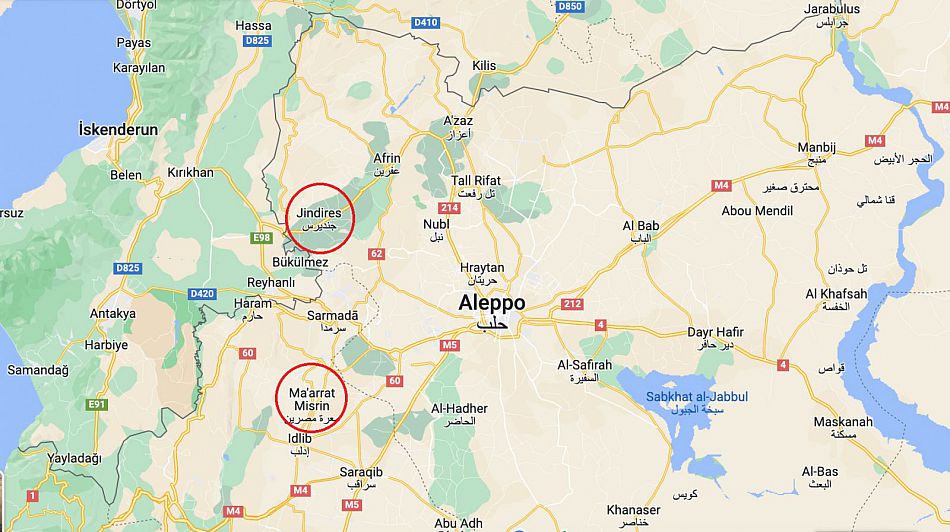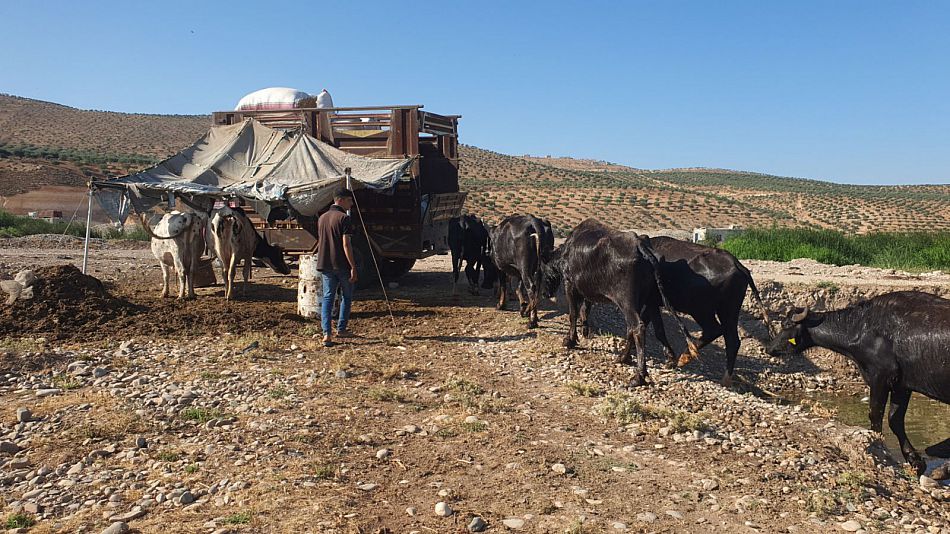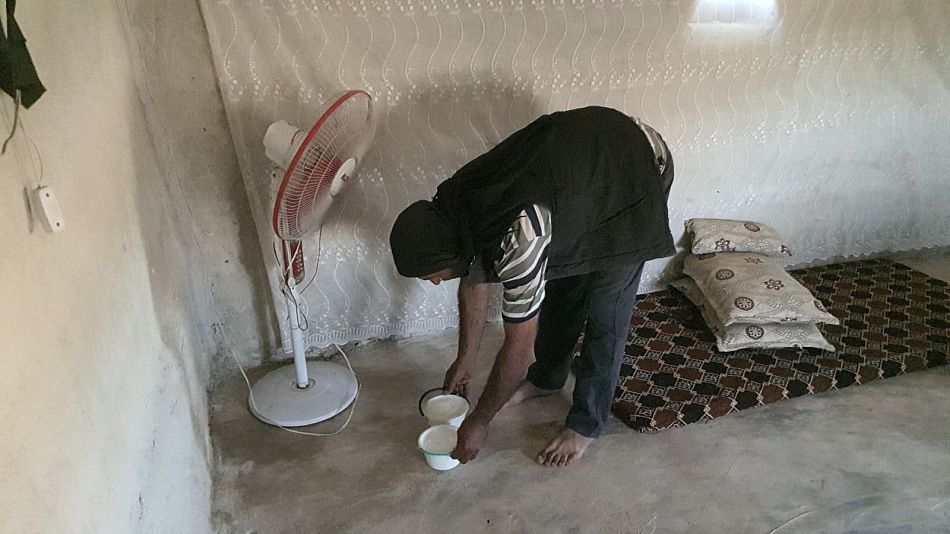Research Brief: Conflict and Fragile Ecosystems
The Livestock and Livelihood Crisis in Northwest Syria
Findings from a study that was implemented in Northwest Syria in the period March-July 2023.
Please find a link to the PDF here.
Authors: Prof Fiona Marshall, SPRU, University of Sussex Business School - f.marshall@sussex.ac.uk, Dr Mirela Barbu, Department of Management, University of Sussex Business School – m.e.barbu@sussex.ac.uk, Dr Shaher Abdullateef, Syrian Academic Expertise, Turkey – shaher.abdullateef@gmail.com
Location of Study
Current buffalo breeding areas: Afrin, Aleppo Governorate and Al-rooj Plain, Idleb Governorate

Introduction
This research brief presents findings and lessons learned from a scoping study that was implemented in Northwest Syria in the period March-July 2023, by researchers from the University of Sussex Business School and the NGO “Syrian Academic Expertise”. This study contributes to an emerging research agenda in which we set out to address two apparently disparate, yet closely connected issues:
- Livestock production in Northwest Syria is in decline. The water buffalo in particular, which represents an important resource for farmers’ livelihoods, is at risk of extinction.
- There is an urgent need to recognize and address environmental land management, alongside humanitarian aid, in protracted conflict zones. This is a fundamental prerequisite to sustaining livelihoods, addressing multiple dimensions of food security and reducing poverty.
We collected data on the role of water buffalo in the livelihoods and food security of vulnerable communities in the Governorates of Idleb and Aleppo in Northwest Syria. We also examined the status of, and access to, resources needed for successful livestock enterprises, with particular emphasis on the ecosystem services that buffalo breeders both depend upon and contribute to. We found a very small number of active breeders in these Governorates and some farmers who had given up buffalo breeding but would have liked to reintroduce buffaloes if the right conditions were to come about.
 Photo 1: Herd taken to pasture, Idleb
Photo 1: Herd taken to pasture, Idleb
This work generated:
- Contextual evidence of the status of the buffalo, its role in livelihoods and challenges faced;
- Contextual evidence of the relationship between the buffalo and the natural environment in a conflict zone;
- Evidence of capability and capacity-building needs necessary for addressing these problems in the long term.
Key Questions
Over a period of five months, we interviewed all the buffalo breeders in Idleb and Aleppo. We collected data on the buffalo's natural habitat and changing access to ecosystem services, alongside household socio-economic data, everyday practices, perceptions and experiences. Qualitative methodologies included participatory observation, shadowing methods and photo mapping to understand and reflect on daily activities[i].
Local and national decision-makers were the second target group of our project. We organised two focus groups in Idleb and Azaz with representatives from the Ministry of Agriculture and Irrigation, local councils and international and national NGOs operating in these governorates, associations of farmers, veterinary doctors and agricultural engineers. The focus groups considered the broader context of livestock breeding in the region and its role in relation to environmental change, poverty alleviation, the status of the local economy etc. They also considered the challenges associated with animal husbandry in Northwest Syria, and ideas and opportunities to address them.
The data collected from the fieldwork was organised in the following themes:
- The socio-economic contribution of livestock and livestock breeding to livelihoods and its cultural relevance.
- Environmental issues impacting upon livestock production and, in particular, water buffalo.
- Strategies for coping in the context of protracted armed conflict.
- Other challenges to livestock breeding including lack of financial resources to access inputs and lack of extension services.
Key Findings
1. Socio-economic contribution and cultural relevance
- Income from buffalo breeding can make up to 75% of the family income but most breeders also need income from other sources, in most cases, other daily work. Monthly family income: highest $500 (100% from buffalo breeding) – lowest $100 (100% from daily work).
- The breeders currently have 55 buffaloes (12 male and 43 female). Before the conflict, their herds were almost six times larger made up of 321 buffaloes (38 male and 283 female). The largest now herd is 15 buffalo.
- Buffalo milk is mixed with cows’ milk to increase the yield of cheese. Milk, cheese and cream are considered the most valuable products and demand is greater than supply. Household consumption is 5-25%, and the rest is sold in the domestic markets. However, transportation is challenging due to lack of refrigeration and safety concerns.
- All members of the family participate in different operations. Fathers and children take the herds to ponds and grazing, milk them and clean the barns. Mothers prepare cheese and different dairy products. Families also use the dung as organic fertilizer or dry and use it for heating. Buffalo breeding has a deep social and cultural significance, embedded in a sense of identity and ancestral heritage.
“Buffalo breeding is important from an economic point of view - it is profitable if appropriate conditions are met - and it is also a legacy from our parents and grandparents. We consider buffalo breeding as part of our work and the source of income that we are used to” (interview with a buffalo breeder in Idleb).
2. Environmental issues impacting upon livestock production and in particular water buffalo
- Lack of access to land and to natural pastures due to conflict (buffaloes eat mainly cattail, reed and scutch grass).
- Lack of agricultural land to grow green fodder which has a high cost (maize and barley are preferred). Alfalfa is becoming the predominant fodder because it is more economically accessible.
- Scarcity of swamps and ponds and lack of cooling systems; knowledge about how to use these is also scarce, and traditional practices prevail. Water buffaloes need to spend about six hours in water to regulate their body temperature.
- Limited local capacity in environmental mapping and monitoring to recognise and support the role of livestock as integral to biodiversity and ecosystem management
3. Coping strategies for armed conflict
- Displacement is very common: the average number of displacements was 10, almost every year since the start of the war. Moving the herds is difficult; each displacement results in some buffaloes being sold and then never replaced.
“We reduced the number gradually. We hoped that the conflict would end, but they were all sold. I wanted to bring the livestock with me, but that was not possible (interview with a former buffalo breeder in Afrin).
- Displacement affected people and animals too. Some herds relocated to colder places where the availability of barns in the winter becomes crucial for maintaining animal health and productivity.
- Importantly though, there is potential for relocation to more appropriate natural habitats that will support livestock; an example being buffalo breeders from the Al-Ghab Plain (Hama), moving to the Al-rooj Plain (Idleb).
- The expansion and maintenance of this approach will require increased awareness by agencies and international donors. It will also require enhanced capacity in environmental monitoring and mapping.
4. Scarcity of financial resources to access inputs and lack of extension services
- Insufficient financial resources to pay for concentrated food and veterinary supplies imported at high prices. The annual income of a family was $12,000 before the conflict; today they earn $5,000 with a herd one-quarter in size compared with the past.
- Collapse of the extension services in agriculture. The projects targeting livestock support in Northwest Syria provide free feed, vaccines and medicines, but their actions are limited within a specific time frame, type of support and specific entities and areas. Often, buffalo owners do not benefit from this support which is available for cattle.
- Limited knowledge and local capacity of alternative livestock production techniques and technologies. Artificial insemination is not available for buffalo in Northwest Syria but it is used, for the same breed, in Turkey.
- Public organisations such as the Syndicates of the Agricultural Engineers and Veterinary Doctors and the Union of Farmers lack the necessary financial resources to operate.
 Picture 2: Buffalo cheese stored in a cool place, Azaz
Picture 2: Buffalo cheese stored in a cool place, Azaz
Recomendations
→ Need to raise awareness of the significance of buffalo. Most of the support that is currently available will target cattle only.
→ Need to improve collaboration between humanitarian organisations operating in the area in order to coordinate actions.
→ Need for humanitarian organisations to work with other local actors to assess needs, implement effective projects and monitor progress.
→ Critical need to move from short-term interventions (provision of feed, vaccines, medicines etc.) based on relief efforts, to more integrated longer-term development actions.
→ Need to match the interventions to the breeders themselves and not to their current location. With frequent displacement, the implementation of projects is not guaranteed.
→ All the actions identified point to the need to identify and map environmental data in relation to the location and relocation of breeders. There is a need to enhance capacity for this and for effective sharing of the data that is collected.
Conceptually and practically, this research enabled us to begin to develop appropriate analytical frameworks for assessing the ecological and social factors that influence the ecosystem services which buffalo provide and are dependent upon. This key element draws on a body of work on ecosystem services, food security and poverty alleviation led by Marshall[ii], which potentially can be adapted to conflict zones.
It also enabled us to reflect on the possibilities for zones of peace[iii] or food and peace hubs[iv] where actions should focus on enduring results. In countries struck by protracted crises and war, local peace processes do take place in certain zones despite conflicts around them. Yet, peace is more likely to be built and sustained when livelihoods in conflict-affected communities can be sustained in the long term.
References
[i] Evidence from participatory observation during buffalo breeding: “A day of a buffalo breeder in Idleb, Northwest Syria” available at https://online.fliphtml5.com/courk/fweq/#p=1 and “Buffalo breeding in Afrin, Northwest Syria” available at https://online.fliphtml5.com/courk/nvtl/#p=1
[ii] Marshall, F. et al. (2018) ‘Ecosystem Services and Poverty Alleviation in Urbanising Contexts’, in K. Schreckenberg; G. Mace and M. Poudyal (eds), Ecosystem Services and Poverty Alleviation: Trade-Offs and Governance, London: Routledge
[iii] Allouche, J. and Jackson, P. (2019) ‘Zones of peace and local peace processes in Côte d’Ivoire and Sierra Leone’, Peacebuilding, 7(1), pp. 71-87
[iv] Delgado, C., Murugani, V. and Tschunkert, K. (2021) ‘Food Systems in Conflict and Peacebuilding Settings. Pathways and Interconnections’, SIPRI, Stockholm, available at https://www.sipri.org/publications/2021/other-publications/food-systems-conflict-and-peacebuilding-settings-pathways-and-interconnections
Funding: This research was supported with Seed Corn Funding awarded by the University of Sussex Business School in February 2023.